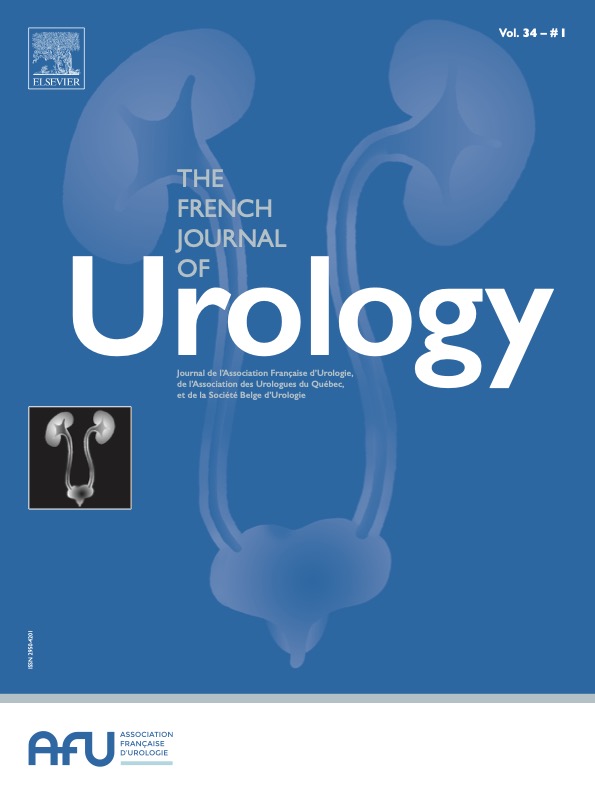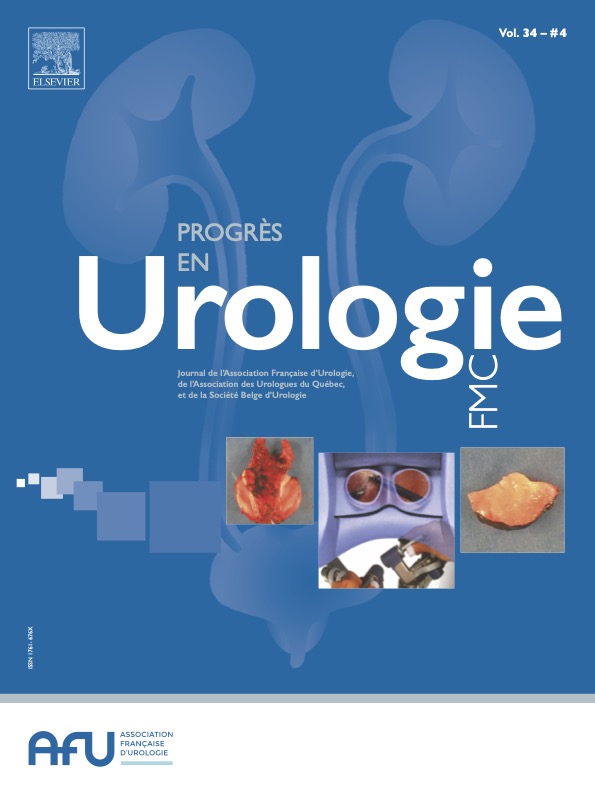| | | 2022 Recommendations of The AFU Lithiasis Committee: Open surgery and laparoscopy Recommandations 2022 du Comité de l’AFU sur la lithiase : chirurgie ouverte et laparoscopie | | | | Each year, only few hundred interventions are performed in France to remove upper urinary tract stones using a laparoscopic/robotic transperitoneal or retroperitoneal approach. The surgical approach has become very rare. The current techniques include: ureterolithotomy, pyelolithotomy, radial nephrotomy, bivalve nephrotomy, combination with endoscopic techniques (percutaneous nephrolithotomy, ureteroscopy nephrectomy). These treatments are proposed only to patients with large (>20mm) and complex stones, sometimes after the failure of endoscopic techniques or in the presence of malformations (ureteropelvic junction obstruction, calyceal diverticulum). The major interest is the removal of the entire stone without prior fragmentation, followed by the possibility to correct some associated malformations. For pelvic stones larger than 20mm, several studies compared percutaneous nephrolithotomy [1] and laparoscopic retroperitoneal, transperitoneal and/or robotic pyelolithotomy [2, 3, 4, 5, 6, 7, 8, 9, 10, 11, 12, 13]. They found that laparoscopic or robotic procedures require longer time than PCNL, but the outcomes in terms of stone-free rate were better (100% in some studies) with similar morbidity. Bleeding was slightly higher in patients treated with PCNL. Laparoscopic pyelolithotomy was more difficult in patients with intrarenal pelvis and significant pelvic fibrosis with a risk of urinary fistula [14]. Some authors compared laparoscopic pyelolithotomy and laser ureterorenoscopy [15, 16], and found better results with laparoscopy (stone-free rate: 90–100% vs 70–76% with ureterorenoscopy), but longer hospitalization. Other studies evaluated anatrophic nephrolithotomy for large and staghorn stones [17, 18, 19, 20] and showed the feasibility of this technique by laparoscopic or robotic approach. The cold ischemia time was 30minutes and the total operative time 180minutes. The stone-free rate ranged between 30 and 88%. Postoperative urinary fistula occurred in nearly 10% [21]. Several studies evaluated the management of ureteral stones >10–15mm by laparoscopy/robotic surgery, PCNL or ureteroscopy [16, 22, 23, 24, 25, 26, 27, 28, 29, 30, 31, 32, 33, 34]. Laparoscopy was associated with postoperative fistula in up to 18% [34, 35] and a stenosis in up to 4% [36]. Postoperative ureteral stenting (double J stent) reduced the risk of postoperative fistula. Few authors addressed the issues linked to the stone nature. As stones mainly composed of struvite are more friable, it is more difficult to remove them “en bloc” and unintentional fragmentation and fragment dispersion may occur [37, 38]. Conventional open surgery displays a higher stone-free rate, but may lead to more important kidney function deterioration. For complex/staghorn stones, Aminshari et al. [8] reported stone-free rates of 93% with open surgery, 44% with PCNL, and 80% with laparoscopy. The length of hospital stay was also longer after open surgery [39]. The comparison of transperitoneal and retroperitoneal laparoscopy showed equivalent results, but the retroperitoneal route displayed longer operative time and less important postoperative ileus [40]. The retroperitoneal approach should be reserved to expert centers [41]. Furthermore, laparoscopy provides good results for the treatment of ureteropelvic junction obstruction associated with stones, but with longer operative time and the need of an endoscope to explore the pyelocaliceal cavities intraoperatively in case of associated calyceal stones [42, 43, 44, 45, 46, 47]. Stones in an ectopic kidney associated with ureteropelvic junction obstruction also have been managed by laparoscopy with good results and a stone-free rate of 100% [48]. Studies that evaluated the feasibility of laparoscopic nephrectomy for damaged kidneys due to stones found a 7% conversion rate to open surgery, particularly in patients with associated xanthogranulomatous pyelonephritis [49].
| | Conclusions of the literature data | • | Laparoscopic/robotic upper urinary tract stone removal techniques are comparable or even superior to endoscopic techniques (level of evidence [LOE1]).
| • | Their major advantage is the removal of entire stones without the need of fragmentation (LOE2).
| • | Transperitoneal and retroperitoneal approaches are equivalent in terms of results (LOE2).
| • | These techniques are effective for the management of stones associated with malformations, such as ureteropelvic junction obstruction (LOE3).
| • | Some anatomical situations may increase the technical difficulty, particularly the presence of intrarenal pelvis (LOE3) and pelvic and periureteral fibrosis (LOE3).
| • | The complications are essentially urinary fistula and ureteral strictures; postoperative stenting (double J stent) reduces these risks (LOE1) ( Recommendation Table 1). |
Seulement quelques centaines d’interventions sont réalisées annuellement en France pour retirer des calculs du haut-appareil par voie d’abord cœlioscopique/robotisée transpéritonéale ou rétropéritonéale. La voie chirurgicale est devenue anecdotique. Parmi les techniques utilisables : urétérotomie, pyélotomie, néphrotomie radiaire, néphrotomie bivalve, combinaisons avec les techniques endoscopiques (NLPC, urétéroscopie), néphrectomie. Ces traitements s’adressent à des calculs volumineux (plus de 20mm) et complexes, parfois après échec des techniques endoscopiques ou en cas d’association avec des malformations (syndrome de la jonction pyélo-urétérale, diverticules caliciels). L’intérêt majeur est l’extraction des calculs en monobloc sans fragmentation préalable. La correction de certaines malformations associées est l’autre intérêt de ces interventions. Pour les calculs pyéliques de plus de 20mm, plusieurs études ont comparé la NLPC et la pyélotomie cœlioscopique rétropéritonéale, transpéritonéale et/ou robotisée [1, 2, 3, 4, 5, 6, 7, 8, 9, 10, 11, 12]. Il en ressort que les interventions laparoscopiques ou robotisées sont plus longues que la NLPC mais que les résultats en termes de SFR étaient meilleurs au prix d’une morbidité équivalente puisqu’ils atteignaient 100 % dans certaines études. Le saignement était un peu plus important chez les patients traités par NLPC. La pyélotomie cœlioscopique s’est avérée plus difficile pour les patients ayant des bassinets intra-sinusaux et des adhérences péripyéliques importantes avec un risque de fistules urinaires [13]. Certains auteurs ont également comparé la pyélotomie cœlioscopique avec l’urétérorénoscopie LASER [14, 15], montrant de meilleurs résultats pour la laparoscopie avec 90 à 100 % de SFR contre 70 à 76 % pour l’urétérorénoscopie, au prix d’une hospitalisation plus longue. D’autres études ont évalué la néphrotomie bivalve pour les calculs volumineux et les coralliformes [16, 17, 18, 19] et ont montré la faisabilité de cette technique par voie laparoscopique ou robotisée. La durée d’ischémie froide était de l’ordre de 30minutes et la durée opératoire totale de l’ordre de 180minutes. Selon les séries, 30 à 88 % des patients étaient SFR. Le taux de fistule urinaire postopératoire pouvait atteindre 10 % [20]. Le traitement des calculs de l’uretère de plus de 10–15mm a également fait l’objet d’études comparant la laparoscopie/robotique avec la NLPC ou l’URS [15, 21, 22, 23, 24, 25, 26, 27, 28, 29, 30, 31, 32, 33]. La laparoscopie s’est accompagnée d’un taux de fistule postopératoire pouvant aller jusqu’à 18 % [33, 34] et un taux de sténose atteignant 4 % [35]. Le drainage postopératoire par sonde JJ a permis de réduire le taux de fistule postopératoire. Peu d’auteurs ont abordé le problème de la nature des calculs traités : les calculs majoritairement composés de struvite étant plus friables, leur extraction monobloc plus difficile peut occasionner une fragmentation involontaire et une dispersion des fragments [36, 37]. La chirurgie classique par voie ouverte a montré un taux plus élevé de SFR au prix d’une détérioration plus importante de la fonction rénale : pour les calculs complexes/coralliformes l’étude comparative d’Aminshari [7] faisait état d’un taux de SFR de 93 % pour la chirurgie ouverte contre 44 % pour la NLPC et 80 % pour la laparoscopie. La durée d’hospitalisation était également plus longue [38]. La comparaison entre la laparoscopie transpéritonéale et la rétropéritonéale a montré des résultats équivalents mais une durée opératoire plus longue par voie rétropéritonéale et un iléus postopératoire moins important [39]. La voie rétropéritonéale serait à réserver à des centres experts [40]. Par ailleurs, il a été montré que la laparoscopie offrait de bons résultats lors des traitements des syndromes de la jonction pyélo-urétérale (JPU) associés à des calculs au prix d’une durée opératoire plus importante, et la nécessité d’utiliser un endoscope pour explorer les cavités pyélocalicielles en peropératoire en cas de calculs caliciels associés [41, 42, 43, 44, 45, 46]. Les calculs sur reins ectopiques associés à des syndromes de la JPU ont également fait l’objet de traitements laparoscopiques avec des résultats satisfaisants et un taux de SFR de 100 % [47]. Les études qui ont évalué la faisabilité des néphrectomies laparoscopiques pour reins détruits par des calculs ont montré un taux de conversion pouvant aller jusqu’à 7 %, en particulier en cas de pyélonéphrite xanthogranulomateuse associée [48].
| | Conclusions des données de la littérature | • | Les techniques d’ablation des calculs du haut-appareil par voie cœlioscopique/robotisée ont fait la preuve de leur efficacité qui est comparable voire supérieure à celle des techniques endoscopiques (NP1).
| • | Leur intérêt majeur est l’ablation des calculs en monobloc sans nécessité de fragmentation (NP2).
| • | Les voies d’abord transpéritonéale et rétropéritonéale sont équivalentes en termes de résultats (NP2).
| • | Ces techniques permettent de traiter efficacement les calculs associés à des malformations telles que le syndrome de la JPU (NP3).
| • | Certaines situations anatomiques peuvent augmenter la difficulté technique, en particulier la présence d’un bassinet intra-sinusal (NP3) ainsi que la présence d’adhérences péri-pyéliques et péri-urétérales (NP3).
| • | Les complications rencontrées sont essentiellement les fistules urinaires, les sténoses urétérales et le drainage postopératoire par sonde JJ diminue ces risques (NP1) ( Tableau de recommandations 1). |
The authors declare that they have no competing interest. | | | |
Recommendation Table 1 - Laparoscopy – robotic surgery.
|

Tableau de recommandations 1 - Laparoscopie – robotique.
|
 | |
| Labate G., Modi P., Timoney A., Cormio L., Zhang X., Louie M., et al. The percutaneous nephrolithotomy global study: classification of complications J Endourol 2011 ; 25 : 1275-1280 [cross-ref] | | | Mantica G., Balzarini F., Chierigo F., Keller E.X., Talso M., Emiliani E., et al. The fight between PCNL, laparoscopic and robotic pyelolithotomy: do we have a winner? A systematic review and meta-analysis Minerva Urol Nephrol 2022 ; 74 : 169-177 | | | Soltani M.H., Hossein Kashi A., Farshid S., Mantegy S.J., Valizadeh R. Transperitoneal laparoscopic pyelolithotomy versus percutaneous nephrolithotomy for treating the patients with staghorn kidney stones: a randomized clinical trial Urol J 2021 ; 19 : 28-33 | | | Mao T., Wei N., Yu J., Lu Y. Efficacy and safety of laparoscopic pyelolithotomy versus percutaneous nephrolithotomy for treatment of large renal stones: a meta-analysis J Int Med Res 2021 ; 49 : [300060520983136].
| | | Xiao Y., Li Q., Huang C., Wang P., Zhang J., Fu W. Perioperative and long-term results of retroperitoneal laparoscopic pyelolithotomy versus percutaneous nephrolithotomy for staghorn calculi: a single-center randomized controlled trial World J Urol 2019 ; 37 : 1441-1447 [cross-ref] | | | Wang K., Wang G., Shi H., Zhang H., Huang J., Geng J., et al. Analysis of the clinical effect and long-term follow-up results of retroperitoneal laparoscopic ureterolithotomy in the treatment of complicated upper ureteral calculi (report of 206 cases followed for 10 years) Int Urol Nephrol 2019 ; 51 : 1955-1960 [cross-ref] | | | Rui X., Hu H., Yu Y., Yu S., Zhang Z. Comparison of safety and efficacy of laparoscopic pyelolithotomy versus percutaneous nephrolithotomy in patients with large renal pelvic stones: a meta-analysis J Investig Med 2016 ; 64 : 1134-1142 [cross-ref] | | | Aminsharifi A., Irani D., Masoumi M., Goshtasbi B., Aminsharifi A., Mohamadian R. The management of large staghorn renal stones by percutaneous versus laparoscopic versus open nephrolithotomy: a comparative analysis of clinical efficacy and functional outcome Urolithiasis 2016 ; 44 : 551-557 [cross-ref] | | | Li S., Liu T.Z., Wang X.H., Zeng X.T., Zeng G., Yang Z.H., et al. Randomized controlled trial comparing retroperitoneal laparoscopic pyelolithotomy versus percutaneous nephrolithotomy for the treatment of large renal pelvic calculi: a pilot study J Endourol 2014 ; 28 : 946-950 [cross-ref] | | | Lee J.W., Cho S.Y., Jeong C.W., Yu J., Son H., Jeong H., et al. Comparison of surgical outcomes between laparoscopic pyelolithotomy and percutaneous nephrolithotomy in patients with multiple renal stones in various parts of the pelvocalyceal system J Laparoendosc Adv Surg Tech A 2014 ; 24 : 634-639 [cross-ref] | | | Basiri A., Tabibi A., Nouralizadeh A., Arab D., Rezaeetalab G.H., Hosseini Sharifi S.H., et al. Comparison of safety and efficacy of laparoscopic pyelolithotomy versus percutaneous nephrolithotomy in patients with renal pelvic stones: a randomized clinical trial Urol J 2014 ; 11 : 1932-1937 | | | Tefekli A., Tepeler A., Akman T., Akçay M., Baykal M., Karadağ M.A., et al. The comparison of laparoscopic pyelolithotomy and percutaneous nephrolithotomy in the treatment of solitary large renal pelvic stones Urol Res 2012 ; 40 : 549-555 [cross-ref] | | | Wang X., Li S., Liu T., Guo Y., Yang Z. Laparoscopic pyelolithotomy compared to percutaneous nephrolithotomy as surgical management for large renal pelvic calculi: a meta-analysis J Urol 2013 ; 190 : 888-893 [cross-ref] | | | Simforoosh N., Radfar M.H., Valipour R., Dadpour M., Kashi A.H. Laparoscopic pyelolithotomy for the management of large renal stones with intrarenal pelvis anatomy Urol J 2020 ; 18 : 40-44 | | | Cicek M.C., Asi T., Gunseren K.O., Kilicarslan H. Comparison of laparoscopic pyelolithotomy and retrograde intrarenal surgery in the management of large renal pelvic stones Int J Clin Pract 2021 ; 75 : e14093 | | | Güler Y., Erbin A., Ozmerdiven G., Yazici O. Comparison of retrograde intrarenal surgery and laparoscopic surgery in the treatment of proximal ureteral and renal pelvic stones greater than 15 mm Folia Med 2020 ; 62 : 490-496 | | | Simforoosh N., Radfar M.H., Nouralizadeh A., Tabibi A., Basiri A., Mohsen Ziaee S.A., et al. Laparoscopic anatrophic nephrolithotomy for management of staghorn renal calculi J Laparoendosc Adv Surg Tech A 2013 ; 23 : 306-310 [cross-ref] | | | Ghani K.R., Rogers C.G., Sood A., Kumar R., Ehlert M., Jeong W., et al. Robot-assisted anatrophic nephrolithotomy with renal hypothermia for managing staghorn calculi J Endourol 2013 ; 27 : 1393-1398 [cross-ref] | | | Aminsharifi A., Hadian P., Boveiri K. Laparoscopic anatrophic nephrolithotomy for management of complete staghorn renal stone: clinical efficacy and intermediate-term functional outcome J Endourol 2013 ; 27 : 573-578 [cross-ref] | | | Giedelman C., Arriaga J., Carmona O., de Andrade R., Banda E., Lopez R., et al. Laparoscopic anatrophic nephrolithotomy: developments of the technique in the era of minimally invasive surgery J Endourol 2012 ; 26 : 444-450 [cross-ref] | | | Qin C., Wang S., Li P.Cao Q., Shao P., Li P., et al. Retroperitoneal laparoscopic technique in treatment of complex renal stones: 75 cases BMC Urol 2014 ; 14 : 16 | | | Lu G.L., Wang X.J., Huang B.X., Zhao Y., Tu W.C., Jin X.W., et al. Comparison of mini-percutaneous nephrolithotomy and retroperitoneal laparoscopic ureterolithotomy for treatment of impacted proximal ureteral stones greater than 15 mm Chin Med J 2021 ; 134 : 1209-1214 [cross-ref] | | | Günseren K., Demir A., Çiçek M.C., Yavaşcaoğlu İ., Kılıçarslan H. Laparoscopic ureterolithotomy; an equally effective and a sensible alternative to flexible ureterorenoscopy in the management of large ureteral stones in terms of effectivity and cost Arch Esp Urol 2021 ; 74 : 592-598 | | | Li J., Chang X., Wang Y., Han Z. Laparoscopic ureterolithotomy versus ureteroscopic laser lithotripsy for large proximal ureteral stones: a systematic review and meta-analysis Minerva Urol Nefrol 2020 ; 72 : 30-37 | | | Choi J.D., Seo S.I., Kwon J., Kim B.S. Laparoscopic ureterolithotomy vs ureteroscopic lithotripsy for large ureteral stones JSLS 2019 ; 2310.4293/JSLS.2019.00008e2019.00008, PMID: 31223226; PMCID: PMC6565372.
[cross-ref] | | | Cavildak I.K., Nalbant I., Tuygun C., Ozturk U., Goksel Goktug H.N., Bakirtas H., et al. Comparison of flexible ureterorenoscopy and laparoscopic ureterolithotomy methods for proximal ureteric stones greater than 10 mm Urol J 2016 ; 13 : 2484-2489 | | | Shao Y., Wang D.W., Lu G.L., Shen Z.J. Retroperitoneal laparoscopic ureterolithotomy in comparison with ureteroscopic lithotripsy in the management of impacted upper ureteral stones larger than 12 mm World J Urol 2015 ; 33 : 1841-1845 [cross-ref] | | | Kumar A., Vasudeva P., Nanda B., Kumar N., Jha S.K., Singh H. A prospective randomized comparison between laparoscopic ureterolithotomy and semirigid ureteroscopy for upper ureteral stones > 2 cm: a single-center experience J Endourol 2015 ; 29 : 1248-1252 [cross-ref] | | | Kaygısız O., Coşkun B., Kılıçarslan H., Kordan Y., Vuruşkan H., Özmerdiven G., et al. Comparison of ureteroscopic laser lithotripsy with laparoscopic ureterolithotomy for large proximal and mid-ureter stones Urol Int 2015 ; 94 : 205-209 [cross-ref] | | | Zhu H., Ye X., Xiao X., Chen X., Zhang Q., Wang H. Retrograde, antegrade, and laparoscopic approaches to the management of large upper ureteral stones after shockwave lithotripsy failure: a four-year retrospective study J Endourol 2014 ; 28 : 100-103 [cross-ref] | | | Topaloglu H., Karakoyunlu N., Sari S., Ozok H.U., Sagnak L., Ersoy H. A comparison of antegrade percutaneous and laparoscopic approaches in the treatment of proximal ureteral stones Biomed Res Int 2014 ; 2014 : 691946 | | | Jung J.H., Cho S.Y., Jeong C.W., Jeong H., Son H., Woo S.H., et al. Laparoscopic stone surgery with the aid of flexible nephroscopy Korean J Urol 2014 ; 55 : 475-481 [cross-ref] | | | Karami H., Mazloomfard M.M., Lotfi B., Alizadeh A., Javanmard B. Ultrasonography-guided PNL in comparison with laparoscopic ureterolithotomy in the management of large proximal ureteral stone Int Braz J Urol 2013 ; 39 : 22-28[discussion 9].
| | | Karami H., Javanmard B., Hasanzadeh-Hadah A., Mazloomfard M.M., Lotfi B., Mohamadi R., et al. Is it necessary to place a Double J catheter after laparoscopic ureterolithotomy? A four-year experience J Endourol 2012 ; 26 : 1183-1186 [cross-ref] | | | Eslahi A., Ahmed F., Rahimi M., Jafari S.H., Hosseini S.H., Al-Wageeh S., et al. Outcome of Transperitoneal Laparoscopic Ureterolithotomy (TPLU) for proximal ureteral stone > 15 mm: Our experience with 60 cases Arch Ital Urol Androl 2021 ; 93 : 330-335 [cross-ref] | | | Nour H.H., Elgobashy S.E., Elkholy A., Kamal A.M., Ali M., Roshdy M.A., et al. Laparoscopic management of distal ureteric stone in bilharzial ureter: results of a single center prospective study J Egypt Soc Parasitol 2015 ; 45 : 309-314 [cross-ref] | | | Tugcu V., Mutlu B., Yollu V., Yucel M., Tasci A.I. Laparoscopic-endoscopic single-site surgery retroperitoneal ureterolithotomy: technique and initial experience Arch Ital Urol Androl 2012 ; 84 : 202-207 | | | Meria P., Milcent S., Desgrandchamps F., Mongiat-Artus P., Duclos J.M., Teillac P. Management of pelvic stones larger than 20 mm: laparoscopic transperitoneal pyelolithotomy or percutaneous nephrolithotomy? Urol Int 2005 ; 75 : 322-326 [cross-ref] | | | Bayar G., Tanriverdi O., Taskiran M., Sariogullari U., Acinikli H., Abdullayev E., et al. Comparison of laparoscopic and open ureterolithotomy in impacted and very large ureteral stones Urol J 2014 ; 11 : 1423-1428 | | | D’Agostino D., Corsi P., Giampaoli M., Mineo Bianchi F., Romagnoli D., Crivellaro S., et al. Mini-invasive robotic assisted pyelolithotomy: comparison between the transperitoneal and retroperitoneal approach Arch Ital Urol Androl 2019 ; 9110.4081/aiua.2019.2.107PMID: 31266278.
| | | Abat D., Altunkol A., Kuyucu F., Demirci D.A., Vuruskan E., Bayazit Y. After a urological laparoscopic training programme, which laparoscopic method is safer and more feasible in the management of proximal ureteral stones: Transperitoneal or retroperitoneal? JPMA 2016 ; 66 : 971-976 | | | An L., Xiong L., Chen L., Ye X., Huang X. Concomitant treatment of ureteropelvic junction obstruction complicated by renal calculi with laparoscopic pyeloplasty and pyelolithotomy via 19.5f rigid nephroscope: a report of 12 cases J Invest Surg 2022 ; 35 : 77-82 [cross-ref] | | | Hüttenbrink C., Kelm P., Klein T., Distler F., Pandey A., Pahernik S. Combination of robotic pyeloplasty and percutaneous renal surgery for simultaneous treatment of ureteropelvic junction obstruction and calyx stones Urol Int 2021 ; 105 : 637-641 | | | Yang C., Zhou J., Lu Z.X., Hao Z., Wang J., Zhang L., et al. Simultaneous treatment of ureteropelvic junction obstruction complicated by renal calculi with robotic laparoscopic surgery and flexible cystoscope World J Urol 2019 ; 37 : 2217-2223 [cross-ref] | | | Jensen P.H., Berg K.D., Azawi N.H. Robot-assisted pyeloplasty and pyelolithotomy in patients with ureteropelvic junction stenosis Scand J Urol 2017 ; 51 : 323-328 [cross-ref] | | | Zheng J., Yan J., Zhou Z., Chen Z., Li X., Pan J., et al. Concomitant treatment of ureteropelvic junction obstruction and renal calculi with robotic laparoscopic surgery and rigid nephroscopy Urology 2014 ; 83 : 237-242 [inter-ref] | | | Chen Z., Zhou P., Yang Z.Q., Li Y., Luo Y.C., He Y., et al. Transperitoneal mini-laparoscopic pyeloplasty and concomitant ureteroscopy-assisted pyelolithotomy for ureteropelvic junction obstruction complicated by renal caliceal stones PLoS One 2013 ; 8 : e55026 | | | Yin Z., Wei Y.B., Liang B.L., Zhou K.Q., Gao Y.L., Yan B., et al. Initial experiences with laparoscopy and flexible ureteroscopy combination pyeloplasty in management of ectopic pelvic kidney with stone and ureter-pelvic junction obstruction Urolithiasis 2015 ; 43 : 255-260 [cross-ref] | | | Angerri O., López J.M., Sánchez-Martin F., Millán-Rodriguez F., Rosales A., Villavicencio H. Simple laparoscopic nephrectomy in stone disease: not always simple J Endourol 2016 ; 30 : 1095-1098 [cross-ref] | |
| | | | | |
© 2023
Elsevier Masson SAS. Tous droits réservés. | | | | |
|









